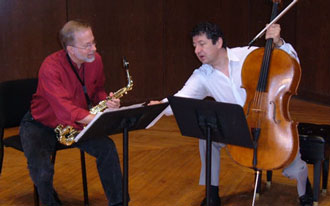Tuesday, July 17, 2012
Ibert Factoid
At dinner in St, Andrews, Scotland earlier this week, Jean-Marie Londeix related an interesting story about the Ibert - Concertino da Camera, probably the most famous saxophone concerto.
Jean-Marie Londeix used to practice and sight-read music with his sister on piano. One day they were playing the Ibert Concertino and M. Londeix's sister mentioned that he was playing a wrong note. He was playing an F-natural (as notated in the score of the earlier editions, mm. 2 and 4 in the excerpt above) and his sister pointed out that it should be an F-flat. Later that week he played the piece in his lesson for Marcel Mule. M. Mule insisted that it should be an F-natural, as in the part. After some discussion, Mule said he'd ask the composer. Jacques Ibert cleared up the misunderstanding and reaffirmed Londeix's sister's observation. From then on, Marcel Mule also played the F-flat.
Daniel Deffayet and Jean-Marie Londeix collaborated on the corrections to the part that is being published today. They fixed some inconsistencies (wrong notes) in the saxophone part, and they added Marcel Mule's articulations. The articulations as published in the earlier part were those of Sigurd Rascher. The articulations that were originally written by Jacques Ibert were published in the original 1935 part, and are still in the orchestral score as published today. Ibert did not call for ANY articulated scales in the entire piece.
Saturday, July 7, 2012
World Saxophone Congress XVI
Here is more information on the pieces I will be performing at the World Saxophone Congress this week:
________________________________________
Wednesday, July 11, 2012. 3:00 pm
All Saints Church
St. Andrews, Scotland
The Onyx Saxophone Quartet
Jonathan Helton, soprano saxophone
Michael Bovenzi, alto saxophone
Joseph Tomasso, tenor saxophone
Don-Paul Kahl, baritone saxophone
Jonathan Elliott
Quartet for Saxophones (2010)
Wheel
Organum
Prayer
Calliope
PBP Music
Georgy Ligeti
Sechs Bagatellen
Allegro con spirito
Rubato, Lementoso
Allegro, grazioso
Presto ruvido
Adagio, mesto (Bela Bartok, in memorium)
Moto vivace, capriccioso
Schott
Adapted to conform more to the original piano work:
Musica Ricercata (1951-1953)
________________________________________
Thursday, July 12, 2012, 2:00 pm
San Salvador's Chapel
St. Andrews, Scotland
The Florida Chamber Saxophonists
Sarah Hersh
Four for Two (2012) World Premiere
Jonathan Helton
Michael Bovenzi
Not published
sarahlhersh@gmail.com
William Albright
Doo-Dah (1977)
Jonathan Helton
Michael Bovenzi
Geoffrey DeibelDorn Publications
Friday, July 6, 2012
Saxophone and Cello
I’ve been performing with cellists since 2002. It all started for me when I bought Edison Denisov’s Sonata for saxophone and cello and went to look for someone to play it with me. My current collaboration is with Steven Thomas, my colleague here at the University of Florida. We’ve been playing together since 2008 and have performed for audiences in the United States, Canada, China, Japan, and France. Watch for our newly recorded CD, Music for Saxophone and Cello, to be released by Centaur in early 2012. Performing with cello has been a lot of fun.
Now, saxophone and cello may seem like a rather unexpected instrumental combination. Okay, it is an unexpected instrumental combination. But, hey, we didn’t make this up. Jean-Marie Londeix’s indispensable Repertoire Universel de Musique pour Saxophone 1844-2003 lists thirty-eight original works for saxophone and cello duo written between 1965 and 2002. Others have been written since and we premiered another new one just a couple of weeks ago.
I find that the saxophone and cello can blend surprisingly well. Truthfully, I am amazed at some of the sounds we make together. To get an idea, you can hear a couple short audio excerpts on our web site at: http://heltonthomasduo.com/
Steven Thomas and I have rehearsed together a LOT. In my many years of playing chamber music I have found that with certain people ensemble playing and musical expression seem to just “click.” Steven and I have this together. Our musical ideas and sensitivity to the expressive needs of a particular piece tend to be very complimentary. It is very nice to be in agreement, or to find that we have the same types of questions for a composer. Also, it did not take us much time to learn to play together, with good ensemble. The sound clips on our web site are taken from our very first concert together. I am really thankful that Steven is willing to put in so much hard work to learn this repertoire. Cellists have so much other great music they can be performing!
Several of the pieces in our repertoire have been with us since the beginning. We have performed Edison Denisov’s Sonata for saxophone and cello(and a few other pieces) over 20 times. Living with music for several years, performing a lot, rehearsing and traveling together all make for an ensemble experience of significant depth and maturity. Every time we come back to familiar music we are surprised at how well it goes together. It’s like putting on a comfortable set of clothes; it just feels right.
We continue to add new music to our repertoire. New music helps us grow as we face new challenges both technical and musical. It also allows us to play return engagements at places that request it! We’ve enjoyed performing a wide variety of pieces and, in many cases, working with the composers who created them.
Subscribe to:
Posts (Atom)

